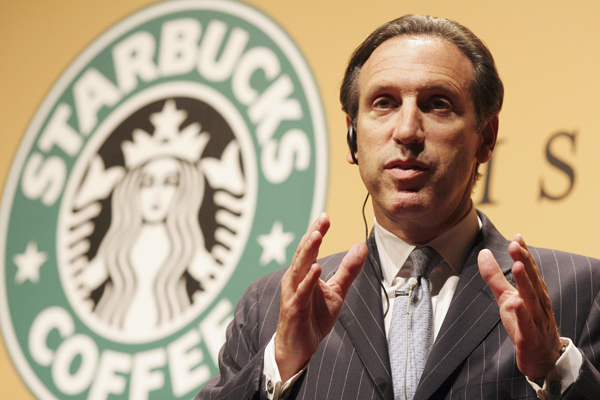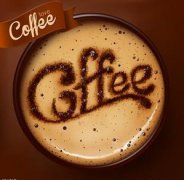Starbucks CEO's road to success Howard Schultz builds coffee kingdom

When Howard Schultz (Howard Schultz), chairman, president and CEO of Starbucks, appeared, he routinely drew cheers and whistles from 1200 employees at the scene. Among the 300000 Starbucks employees around the world, he is an idol, not only because of his business miracles, but also because he insists on promoting the concept of "sharing" and "respect" within the company. he has always been called a "partner" to his employees.
This year, Howard went to China for the second time to have face-to-face exchanges with his "partners and family members." this time he was greeted by 1200 "partners" and their families in Guangzhou. The fast-expanding company now has 1200 stores and nearly 20,000 "partners" in China, compared with just 450 three years ago. China will become Starbucks' second-largest market after the United States by the end of this year. Starbucks is currently launching a "partner go home" program in China-"partners" who want to take care of their families more closely are beginning to have the opportunity to serve as managers of new stores in the nearest city. This humane program is organically integrated with Starbucks' expansion in China's second-and third-tier cities.
Howard Schultz, 61, still has a tall figure and deep eyes, and most of his life is still dominated by work: getting up at 04:30 every morning to make himself a cup of French coffee. Read three newspapers at the same time you eat breakfast. Then start taking the family's three dogs for a walk before going to exercise. After making a cup of coffee for my wife at 06:30, I went to work. For more than 20 years, he has insisted on visiting 25 stores a week and participating in some strategic meetings of the company every day, including special store design, marketing strategy, etc. Recently, he revealed that he often participates in meetings on e-commerce and digital marketing. "I think luckily I don't need to sleep too much, so I have a lot of time to use," he joked. "
Inside Starbucks, there is a story describing Howard's work frenzy: the first thing he did when he returned as CEO in 2008 was to invite his "buddies" to email him directly and received about 5000 emails in the first month, all of which he tried to respond to.
Although they have grown from a slum teenager to the king of the coffee empire that now controls more than 20,000 coffee shops around the world, Howard and his wife still teach their children that wealth or career success does not mean privilege, but responsibility; personal self-esteem depends on hard work, and the respect of others comes from sharing and helping others. In his philosophy, Starbucks never existed to make money. Since its inception, he has been trying to make Starbucks a unique company: here, the most important asset is the "partner", followed by the customer, and finally the shareholder. "partner" is the soul and core of Starbucks experience culture.
Over the past few years, the global economy has experienced a severe recession or crisis, but Starbucks' performance has bucked the trend and has been rising since 2010. In the first quarter of 2014, Starbucks' net profit rose 9% year-on-year, while same-store sales rose 6%, making it a growing company for several consecutive quarters. Howard believes that this is the best period since Starbucks was founded more than 40 years ago, and it still has more opportunities and room for development in the future, but he hopes to boost its performance by stimulating and nurturing the humanistic spirit of Starbucks. At any time, the indicator he is most concerned about is whether Starbucks experience culture is good enough, not profit or scale.
Coffee connects the people.
Although Howard, the founder of the coffee experience culture, has a large number of fans, including successful entrepreneurs, in Howard's view, the most important core of being a great leader is not charisma or personality. For everyone, what they need to see from the leader is openness and transparency, a kind of trustworthy sincerity, and people follow him, not because he can tell people what to do, but also because he can make people understand why they do it. What is the meaning and mission of the existence of the enterprise?
And he thinks the most important thing is that as a good leader, the responsibility of an organization and the rewards that can be obtained must be established at an early stage, and this reward must be shared by everyone. "it's like a sports competition that has to be reached by a team."
This idea stems from Howard's childhood imprint. He made no secret that he was born in Brooklyn, New York, and his father was a truck driver who never earned more than $20, 000 a year. When he was seven years old, his father was fired because he broke his leg in delivery, and the whole family was in trouble ever since. After that, in addition to working part-time to support his family, Howard also began to practice American football and eventually won an athlete scholarship from the University of Northern Michigan to enter the university. Later, he joined the Swedish household utensils business as a salesman. because of his hard work and outstanding achievements, he was promoted to vice president at the age of 26. By chance, he discovered Starbucks and developed the store, which used to only sell coffee beans, into a super retail brand that sells more than $10 billion a year.
Howard said that when he was a child, he was saddened to see his father's suffering and felt that his work was not respected, but he was unable to help him at that time. When he has the ability, what he wants to build is a company that can share the success and wealth of the company with everyone in the company, a company that his father has never had the opportunity to work for, and a company that his father has never enjoyed before.
Starbucks currently offers health insurance to all part-time employees who work more than 20 hours a week. and any "partner" can buy stock options under the stock purchase plan after working 90 days (during which time he needs to work at least 20 hours a week)-including in China, "partners" can get a 15% discount on their salaries when buying shares. This is very rare among listed companies around the world. Data show that since Starbucks went public in 1992, its share price has increased by more than 50 times. If the "partner" has been holding stock options, there is no doubt that the profit is very considerable.
If shareholders want to complain about Starbucks' health care costs, Howard's response is usually "you can sell your shares, and I won't change my mind because of shareholder opposition." In a sense, Starbucks dividend is not really a company trying to give back to shareholders, but a new way for CEO to put its employees' interests first-- dividends are just a new employee incentive in addition to free coffee, tuition subsidies and health insurance.
In addition, Starbucks conducts voluntary work in different communities around the world in April every year, so as to deepen the emotional bond between the Starbucks brand and the local community. Starbucks "partners" in China will have more than 100000 hours of community voluntary work by the end of this year. Howard believes that "partner" is the key link of "good sales experience". Only when "partner" feels happy can we bring a good experience to customers.
Starbucks has a mature store management and coffee knowledge training system, including Starbucks University, as well as a variety of career promotion paths. Starbucks' unique "family" culture gives its employees a unique sense of happiness and achievement, resulting in: Starbucks in all markets around the world, its staff turnover rate is lower than the average turnover rate of the local retail and catering industry.
Howard, who drinks five cups of coffee a day and claims that "his blood has turned brown", in addition to loving coffee and caring for his employees, another well-known gene is his love of innovation.
For example, Howard revealed that 15 years ago, when Starbucks wanted to expand beyond Europe and the United States, he chose China. At that time, many people advised him that Chinese people only drink tea rather than coffee, and that the future of coffee expansion should be in India. But Howard believes that the Chinese do not like coffee is an opportunity, he has always been full of confidence in the Chinese market, in the restructuring after 2008, Starbucks mainly closed stores in Australia or the United States. On the other hand, the Chinese market is moving towards Starbucks' largest overseas market.
After returning as president of Starbucks in 2008, Howard established "creating an innovative growth platform commensurate with our coffee" by adopting new technologies and introducing new foods; exploring digital networking technologies for social media and stores; expanding overseas operations, launching concept stores, and being a leader in ethical procurement and environmental protection, Starbucks is back into quality growth. He also decided to close hundreds of unprofitable stores and drive growth through innovation rather than new stores.
Starbucks sees product innovation as a recipe for growth, such as launching new tea drinks and snacks in global stores and developing food and coffee drinks that suit local tastes. Starbucks has gone further in localization than its peers in other coffee brands since it announced in 2011 that China would become Starbucks' largest overseas market in 2015, with the goal of opening 1500 stores. It began to sell traditional Chinese festival food moon cakes and zongzi. On Valentine's Day, it served peach blossom Ruyi lattes and continued to launch new products according to seasons and specific festivals.
In terms of management structure, Starbucks has already recovered part of its stake in the joint venture business in China, which was originally jointly operated by three companies in 2011. at present, except for the joint venture between Jiangsu, Zhejiang and Shanghai, all the stores in other regions have been directly operated. And operational decision-making power has also been devolved from headquarters to the Asia-Pacific region. In the store decoration, Starbucks has appeared bamboo and other environmentally friendly designs with Chinese elements, while the location is no longer confined to the business district, but also began to move into the well-known scenic spots.
'no matter where we are, how developed our business is, no matter how good the status quo is, it's not enough, 'Mr. Howard said. We need to constantly reinvent ourselves and use more innovation to adapt to today's market environment. And local innovation is a very important part. Only in this way will Starbucks not be as fleeting in China as other American trends.
Since returning to CEO in 2008, Howard has made many big decisions: clarify the background of Starbucks' time and reposition Starbucks' role in it. Unlike most stories where the founder's return rarely ends well, he created a comeback for himself and Starbucks. And he personally pushed Starbucks into the digital age because "We are not a company that only sells coffee, we are a brand dedicated to getting people to connect." When we see the development of new technology, we redefine the way we connect people.
When the "third space" advocated by Starbucks is well known, it is rapidly creating a "fourth space" based on the mobile Internet. Starbucks' Starbucks card already has 7 million members in the United States, and its FACEBOOK account ranks among the top five fans; all stores can use mobile payments. In China, Starbucks'"fourth Space" refers to social media and consumer-connected platforms dominated by mobile APP, Weibo and Wechat, which already have 2 million followers.
Through technology, Starbucks can keep track of the tastes of local target consumers and feedback on brands anytime, anywhere, and its social media programs are not limited to communicating with brands among customers. what's more, it hopes to provide a platform for customers to communicate with each other through social media. Digitization helps Starbucks clerks and companies tell Starbucks stories, build brands, and connect with customers.
Sometimes we often say that the amount of tasks assigned by the company is too much for us to do. But compared to Howard? I have to get up after 4 o'clock. What is the concept? Will office workers who still go to work at nine o'clock feel ashamed? Howard's day's work. A normal CEO can take a week to work. Work efficiency determines what position to stand in. Through an exclusive interview with Starbucks CEO Howard, I admire Howard's attitude and enthusiasm for his work. The editor will work hard at Howard.
Important Notice :
前街咖啡 FrontStreet Coffee has moved to new addredd:
FrontStreet Coffee Address: 315,Donghua East Road,GuangZhou
Tel:020 38364473
- Prev

Running a coffee shop asks the boss what you need to know to open a coffee shop.
Rome was not built in a day, nor was Rome built in a day. Anyone can open a coffee shop as long as there is enough money, but do you think it is so easy to be a coffee shop owner? I don't know who said such a sentence, if you love someone, let him open a coffee shop, hate someone and let him open a coffee shop. This sentence aptly describes the actual state of a coffee shop operator.
- Next

Reveal the other side of Starbucks: only push brands but not sell coffee
Starbucks targets consumers in white-collar groups. Note that in the positioning of Starbucks in China, white-collar workers are a state, not an identity. A considerable number of urban white-collar workers are literary youth and heavy consumers of coffee shops, but Starbucks will never place its position on the status of literary and artistic youth, even though they have a good chance of being the same person. Why
Related
- What documents do you need to go through to open a coffee shop? coffee shop coffee shop certificate processing process
- How to purchase Coffee beans in small Cafe how to choose a suitable supplier for domestic Coffee supply Company
- How to drink Starbucks Fragrance White Coffee? how to make Australian White Coffee? what Italian coffee beans are recommended?
- The Story of Flora Coffee: the name of Flora Coffee Bean and the implication of the Flowers on Florna Coffee
- How much does a cup of coffee cost? How much is the profit of a cup of coffee? What is the profit of the coffee shop in a year?
- Yunnan small Coffee, known as "fragrant Coffee", introduces the characteristics of Alpine Arabica Coffee producing areas in Yunnan, China
- 2023 latest Starbucks full menu price list how much is a cup of Starbucks coffee what is better to drink the most popular hot and cold drinks recommended
- Starbucks different kinds of Coffee Price list Starbucks menu 2023 Top Ten Best drinks in Starbucks
- Starbucks Spring praise Comprehensive matching Coffee Bean theme Story Packaging implication and taste description
- The cost of a cup of coffee latte American coffee cost price and selling price

